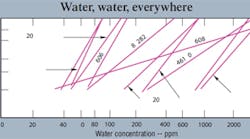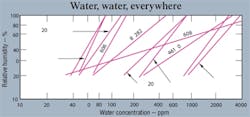Edited by Alan L. Hitchcox, editor
Hydraulic system designers go to great lengths to keep dirt out of hydraulic fluid — and rightly so. But water in oil-based hydraulic fluids can be just as destructive as particle contaminants. Because of its affinity for other liquids, water is present in some concentration in most hydraulic systems. The hygroscopic nature of liquids causes them to pick up a certain amount of water simply from contact with humid air. When condensation occurs in a reservoir, with subsequent mixing into the base liquid, even more water can enter the system. Water can even enter with new oil. An oil barrel stored outdoors in a vertical position is likely to have rainwater collect around its opening. With changes in ambient temperature, some of this moisture can be sucked into the barrel. Eventually, this water enters the system when the reservoir is filled from that barrel.
Besides these natural phenomena, several system- and maintenance-related sources of water occur. Water can enter hydraulic systems through breather caps and imperfect piston rod seals. Worn and damaged heat exchangers can allow cooling water to leak through seals and ruptured lines into the oil system — and vice versa.
Each fluid has its own saturation level for water. Below the saturation level, water can be completely dissolved in the other fluid. For oil-base hydraulic fluids, the saturation level is likely to be in the range of 100 to 1000 parts per million (0.01% to 0.1%) at room temperature. The saturation level is greater at higher temperatures.
Free and emulsified water in oil
Above the saturation level, water becomes entrained, meaning that it takes the form of relatively large droplets. This is sometimes referred to as free water. This can cause slow or erratic response in hydraulic systems. The droplets can combine and collect at the bottom of the reservoir. If free water is present in hydraulic fluid, and the system operates at temperatures below 32° F, ice crystals may form and can plug component orifices and clearances. In mobile equipment, churning action can cause undissolved water to emulsify — meaning that it exists as very fine droplets suspended in the oil.
Evidence of water droplets emulsified in oil-based fluid is fluid that appears to be cloudy or milky. Sometimes an oil-water emulsion is so fine that it is difficult to separate the two fluids — even with the addition of a coalescing agent formulated to do this. Some fluid additives encourage emulsification, while others (demulsifiers) discourage it.
Water’s detrimental effects
The response of a hydraulic system usually becomes sluggish when water concentration in hydraulic oil reaches 1% or 2%. Slow system response could be the first indication that water is present. Water existing in the hydraulic fluid long enough and at a high enough concentration can reduce its viscosity, which reduces the thickness of lubricating films and leads to rapid wear of surfaces in dynamic contact. Other symptoms include deposits of chemical-reaction products.
Cavitation is another symptom of water in the fluid. Because the vapor pressure of water is higher than that of hydrocarbon liquids, even low concentrations of water can cause cavitation in hydraulic components. Cavitation occurs when water vaporizes in the low pressure areas of components, such as the suction side of a pump. Vaporization is followed by the subsequent violent collapse of vapor bubbles against metal surfaces in these areas. The characteristic loud banging of cavitation may be noticeable when this happens. The result is damage to the interior surfaces of hydraulic components.
Without fluid analysis to indicate the presence of water and without taking appropriate countermeasures, water content will increase until system failure occurs.
Chemical reactions from water
Water reacts with almost everything in a hydraulic system. Water promotes corrosion through galvanic action by acting as an electrolyte to conduct electricity between dissimilar metals. The most obvious sign is rust and other oxidation that appears on metal surfaces. The inside top surface of the reservoir often is the first place rust becomes visible, but such rust still may go undetected unless the reservoir is drained and opened for servicing.
Unfortunately, before rust is noticed in the reservoir, water probably has damaged other system components. An inspection of failed bearings and other components may point to corrosion damage. Corroded aluminum and zinc alloys could have a whitish oxide film. Steel bearing and gear surfaces may show signs of rust and pitting.
Water’s reaction with a fluid’s oxidation inhibitors produces acids and precipitates. These water-reaction products also increase wear and interference. Water reacts with and actually can destroy zinc-type antiwear additives at temperatures above 140° F. For example, zinc dithiophosphate (ZDTP) is a popular boundary lubricant added to hydraulic fluid to reduce wear in high-pressure pumps, gears, and bearings. When this type of additive is depleted by its reaction with water, abrasive wear will accelerate rapidly.
Water can also act as an adhesive, causing smaller contaminant particles to clump together. These sticky masses may slow down a valve spool or cause it to stick in one position. The masses can also plug component orifices and filters. In any case, the result is erratic operation or complete system failure.
Microbial growth
Over time, water contamination can lead to the growth of microbes — minute life forms such bacteria, algae, yeasts, and fungi — in the hydraulic system. Microbes range in size from approximately 0.2 to 2.0 μm for single cells, and up to 200 μm for cell colonies. Left unchecked, microbes can destroy hydraulic systems just as they destroy living organisms. The presence of air exacerbates the problem.
Bacteria can double their population as rapidly as every 20 minutes. Such exponential growth can form an interwoven mat-like structure that requires significant shear force to break up. This resistance quickly renders a fluid system inoperable. Besides their mass volume, bacteria produce acids and other waste products that attack most metals. When this happens, fluid system performance is degraded and components fail more rapidly.
The first indication of microbial contamination may be a foul odor that comes from waste and decomposition products of the microbes. Fluid viscosity may increase due to the mass of material produced by these organisms. At the same time, the fluid may have a brown mayonnaise-like appearance, or slimy green look.
Unfortunately, by the time these symptoms appear, system components and the fluid itself may be severely damaged. This could require a major overhaul or replacement of the system.
Properly selected filters can remove microbes. But without adding biocides to destroy these living organisms, fast-growing microbes can place a heavy load on filters. Microbial contamination can result in rapid plugging of filter elements, especially when combined with wear debris and chemical reaction products.
So what can be done?
The most effective means of avoiding problems from water is to keep it from entering the hydraulic system in the first place. This means specifying tight seals on piston rods to inhibit water ingestion. Better yet, flexible boots on piston rods operating in the wettest environments can keep moisture and dirt out of the hydraulic system.
But water enters most hydraulic systems through the reservoir breather. Desiccant breathers are now widely available to ensure that any air drawn into the reservoir is dry. Reservoirs can also be fitted with a bladder to completely seal the hydraulic fluid from the ambient environment (read details in this month’s “Ideas & Applications”).
Even so, water can still find its way into a hydraulic system. When it does, consult a distributor or filter manufacturer to incorporate effective water removal filters for your system.
This information was excerpted, in part, from the Fluid Power Handbook & Directory. For more information from our Fluid Power Handbook & Directory on hydraulic fluid contamination and filtration, click here.
Find suppliers of water removal filtersTo find companies that offer filters for removing water from hydraulic fluid, click here. The link will take you to the home page of our Designer’s Guide. Click the heading for "Filters, hydraulic." The third column heading reads “Element,” and a sub-heading under it reads “Water absorption.” Companies with a dot in the Water absorption column offer filters for removing water from hydraulic fluid. If you contact any of these companies, please mention that you found them through Hydraulics & Pneumatics.


